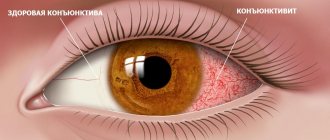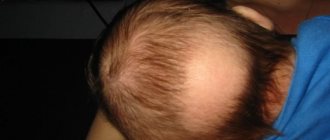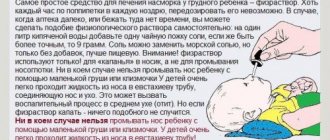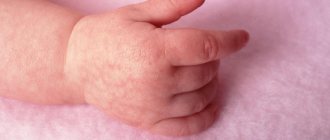In the first days after birth, the child’s body is very vulnerable.
The immune system is imperfect, many eye structures are underdeveloped. Particular attention should be paid to the organs of vision.
Tears are a common occurrence for everyone. But not for a newborn baby. If lacrimation occurs for no reason, or the eye turns sour, you should immediately consult a doctor. There are many reasons for this symptom. In some cases, the discharge disappears after some time, in others, urgent medical attention is required.
Symptoms
Tearing in newborns under one year of age is not normal. The symptom doesn't just appear. Rarely does the symptom occur independently; more often it is a sign of an inflammatory process.
It is also related to age. Babies under 2 months cry without tears, this is due to the immaturity of the corresponding glands. If your one-month-old baby has excessive tearing, this is a reason to make an appointment with your pediatrician and get a referral to an ophthalmologist.
The following symptoms may accompany lacrimation:
- conjunctival irritation;
- hyperemia of the mucous membrane;
- secretion - tears or pus;
- the child becomes restless and capricious.
Causes
Dacryocystitis
The congenital form develops with an abnormal development of the nasal opening of the nasolacrimal duct. The reason lies in the fact that the film that closes the duct during intrauterine development does not break at birth.
As a result, there is no normal outflow of tear fluid into the nasal cavity. Its stagnation occurs and a favorable environment for bacteria is formed.
According to statistics, the film is preserved in 1–7% of children. The disease manifests itself in scanty purulent discharge in the conjunctival sac at 1 month of life. By 3 months, lacrimation and lacrimation are detected. With dacryocystitis, one eye often becomes watery.
Conjunctivitis
The cause of the development of conjunctivitis is external factors, most often infectious agents. Often conjunctivitis develops after the baby is born. It is associated with an insufficiently developed immune system of the newborn, insufficient preventative measures in the premises, or improper care of the baby.
Conjunctivitis is manifested by swelling of the eyelids, the baby rubs its reddened eyes, and a burning sensation appears, which the baby reports by crying.
With this disease, two eyes are affected simultaneously, and with dacryocystitis, discharge is observed only from the eye in which the film remains in place.
Aplasia
This is a focal disorder of the development of the skin, in which scars form. As a rule, the lesion affects the scalp and face; other areas of the body may also be affected.
Causes of congenital aplasia:
- genetic transmission of the disease;
- other developmental pathologies that arise against the background of genetic diseases - congenital heart disease, muscular ventricular septal defect, signs of meningoencephalitis and hypoxic-ischemic brain damage.
Lacrimal sac fistula
Disease of the lacrimal ducts develops from birth. It is one of the most common eye pathologies in childhood and accounts for 7–20% of all ophthalmological pathologies.
The developmental anomaly can only be treated surgically.
Foreign body
If the eye is watering, the causative factor may be dust, eyelashes or dirt. It is not recommended to independently remove foreign particles that are not washed away by excessive tearing.
During the removal process, there is a risk of infection that will spread to other structures of the visual organ.
Damage to the tear duct
Through the lacrimal canal, fluid is transferred into the nasal cavity, into the inferior nasal concha from the nasolacrimal canal. Damage is possible from a fall or excessive pressure on the eye while swimming or washing.
Eczema
The pathology is characterized by dry skin and peeling of the eyelids. The eyes become sour, the child becomes nervous and capricious. Causes of eczema in an infant:
- dyes and flavors in body care products;
- a bite of an insect;
- worms;
- Excessive consumption of citrus fruits by the mother while breastfeeding.
The first symptoms of eczema appear on the cheeks, then on the eyes, knees, neck, wrists, elbows and tops of the feet.
Allergic reaction
In addition to watery eyes, itching, nasal discharge, redness of the mucous membrane of the eyes and skin irritation will appear.
An allergic reaction is the action of external factors or the consumption of new foods, especially red, yellow or orange.
ARVI
Colds also cause excessive tear production. At the same time, sneezing, nasal discharge, coughing, and fever appear. The child becomes irritable, lethargic, and sleep is disturbed.
Once your cold is cured, your lacrimation will go away.
Sudden temperature change
Tearing is a normal physiological reaction of the body when leaving a warm room in the cold. It works even in adults. The eyes are protected from sudden temperature changes and moisturized.
Why does my eye water?
The baby himself will not complain, he will not tell, because he is still small. But experts know for what reasons this symptom may occur.
Cold. If the baby suffers from tearfulness, plus he has a cough, a small child sneezes and suffers from a runny nose, the temperature is elevated, then the reason is precisely an acute respiratory infection. You should definitely contact a pediatrician who will examine and prescribe therapy. As the child begins to recover, the lacrimation will disappear. Allergy. The answer to the question of why a baby’s eye waters can be answered by saying that this is a manifestation of an allergic reaction. At the same time, the eye itches and itches. A highly specialized doctor will help you make an accurate diagnosis and find out exactly what the baby is reacting to. Such a reaction occurs not only under the influence of external factors, but also due to the diet of the nursing mother. Children from 1 month to 1 year old can also suffer from food causes. Eczema. This is a more complex form of allergy manifestation. Other symptoms include dry, flaky eyes. Canaliculitis. Occurs due to an abnormality of the tear ducts. And since the shape is incorrect, inflammation occurs, which also manifests itself as tearing. The tear duct is injured. And the reason is not that children rub their eyes carelessly with their hands.
Sometimes an overly caring and loving mother can wash the eyes so intensively that this will lead to careless damage to the canal and associated symptoms. Foreign body in the eye. A baby may suffer from watery eyes if an eyelash or a particle of dust gets into it
Then one eye of the baby becomes watery and red, and you begin to look for ways to independently remove the foreign body, but supermams.ru advises visiting the traumatology department. Temperature jump. If a child suddenly goes from warm to cold and vice versa, then lacrimation in this case is a normal reaction, protective, and then no specific intervention is required. It is important to provide the baby with normal conditions.
Diagnostics
A pediatric ophthalmologist will examine your newborn's eyes and may order some tests to determine the cause. Tests are taken if the eye is watery and festering. They will help determine the type of agent that led to the development of the infection.
The ophthalmologist analyzes the medical history and family history. The diagnosis is determined based on the clinical picture.
If the preliminary diagnosis is eczema or an allergic reaction, they are referred to a dermatologist. The doctor conducts a differential diagnosis to exclude other pathologies, finds out the cause and prescribes a histological examination of the damaged tissue.
Allergic conjunctivitis in a 6-month-old child
Allergies appear very quickly. In some cases, the first signs appear within 1-2 hours after a person comes into contact with the allergen. A typical sign of any allergic conjunctivitis is unbearable itching. The child will not say this, but you can observe his behavior. He constantly squints, rubs his eyes with his hands, cries, and sleeps restlessly. Another characteristic sign of this type of inflammation is lacrimation. Pus and mucus are not observed. If discharge of this nature appears, most likely, bacterial conjunctivitis develops in parallel with the allergy.
An allergic reaction is treated with antihistamines. Children, as a rule, are not prescribed glucocorticosteroids. They are very powerful. The need for them arises only in severe inflammation.
Treatment of blocked tear ducts
Initial treatment is conservative. The baby is given a lacrimal sac massage. Massaging forces fluid through the tubules and removes the blockage. Antibacterial agents are prescribed in the form of eye drops.
If medications and massage do not help, a probe is inserted into the nasolacrimal canal. Helps remove obstacles.
If the tear duct blockage does not resolve by 12 months, the chances of spontaneous resolution are low. It is recommended to perform a tear duct opening procedure. Balloon dilatation is performed. The risk of intervention is rupture of the lacrimal canaliculus, a complication that can be corrected.
If balloon dilatation does not help, the child will have a silicone tube inserted for a long time.
Treatment of conjunctivitis
For mild cases of the disease, rinses and chamomile compresses are not prescribed. Doctors do not recommend using “grandmother’s methods” for a child under 1 year old. Mild stages of the disease are treated with artificial tears. The drug is instilled up to 5 times a day, it washes away pathogens and moisturizes the mucous membrane.
If improvement does not occur after 2 days, antibiotics are prescribed. Eye drops or ointment will alleviate the baby's suffering.
For viral conjunctivitis, antiviral eye drops are prescribed. For any form of disease, wash the eyes with antiseptic solutions.
Do not instill breast milk or rinse with tea or unboiled water.
If one eye is affected, carry out prophylaxis for the second and make sure that the child does not touch the other eye with his hands.
After and before handling, wash your hands with antibacterial soap. Use a separate towel for the baby so that other family members do not become infected.
How can you help if your baby's eyes are watery?
Depending on the cause of abnormal tearing, your doctor may recommend:
- washing with disinfectant solutions in the appropriate dosage (dacryocystitis and conjunctivitis);
- disinfection of inflamed surfaces with ointments that relieve swelling and itching;
- drops identical to the natural composition of tears with an antibacterial effect. Remember that infants at 1 month, 3 months, six months and a year need different dosages and active substances in the drug, so follow the pediatrician’s prescription;
- anti-eczema creams that minimize skin dryness and restore its natural elasticity;
- drugs that lower histamine levels, anti-allergenic drugs are extremely rarely prescribed to children under 12 months, independent use is strictly contraindicated;
In addition to medications, a baby’s tears will help remove:
- Massage every 3 hours. Using circular movements from the cheekbones to the eyebrows, it is easy to massage the baby's face. Such actions calm the child, and stroking and pressing help strengthen the subcutaneous vessels and contribute to the rapid release of the infectious focus to the outside, where it is easier to eliminate it by washing.
- Folk remedies (only after discussion with your doctor!). Anti-inflammatory and aseptic decoctions can be prepared from chamomile flowers, caraway seeds, and red rose petals. You can use the resulting products to wash the newborn’s eyes 2-3 times a day, preferably after waking up. It is not recommended to take decoctions internally; this can lead to diarrhea and problems with the baby’s intestines.
Prevention
Infants have a higher risk of getting an infection and catching a virus, since the body is not strong after birth. He continues to adapt to the external environment and parents should help with this.
To avoid the development of ophthalmic problems, you should follow good hygiene and visit your pediatrician every month during the first year of life.
To prevent your eyes from watering, follow these recommendations:
- wash the eyes carefully, do not press, wipe the baby with a towel moistened with water;
- make sure that the baby does not actively rub his eyes;
- protect from strong drafts and wind;
- maintain optimal humidity in the room so that the mucous membrane does not dry out;
- do wet cleaning more often.
It should be remembered that lacrimation at 2 months is not the norm; during this period, the baby has not formed all the structures of the visual analyzer. Excessive production of tears during this period is a pathology.
If a child is 2–5 months old or a child under the age of one year or older has a watery eye, do not look for an answer from girlfriends and on forums. A medicine that suits one baby may not suit another. In addition, the mother cannot make a diagnosis based only on this symptom.
Why is conjunctivitis dangerous in infancy?
In the absence of treatment, if it is started late or carried out incorrectly, conjunctivitis can become chronic. In the first year of life, such a development of events can affect the process of formation of the child’s visual organs. Conjunctivitis also has complications - keratitis, keratoconjunctivitis, etc. With these diseases, vision deteriorates. Some forms of inflammation can lead to panophthalmitis - purulent melting of the entire eyeball. This does not happen often, but it is better to take all possible measures to prevent such developments. If you notice that your child's eyelids are red and his eyes are watery, show him to the doctor.
Useful video
Dr. Komarovsky talks in detail about lacrimation in newborns:
Author's rating
Author of the article
Alexandrova O.M.
Articles written
2100
about the author
Was the article helpful?
Rate the material on a five-point scale!
( 2 ratings, average: 5.00 out of 5)
If you have any questions or want to share your opinion or experience, write a comment below.










